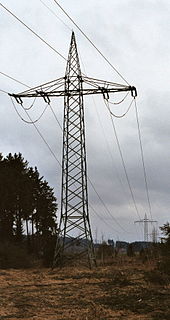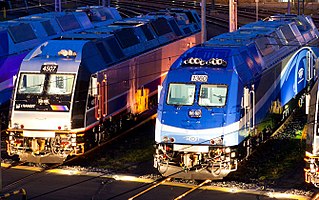Related Research Articles

A traction network or traction power network is an electricity grid for the supply of electrified rail networks. The installation of a separate traction network generally is done only if the railway in question uses alternating current (AC) with a frequency lower than that of the national grid, such as in Germany, Austria and Switzerland.

The EMD F59PH is a four-axle 3,000 hp (2 MW) B-B diesel-electric locomotive built by General Motors Electro-Motive Division in two variants from 1988 to 2001. The original F59PH was designed in consultation with GO Transit for commuter operation in Toronto. The design was successful and became the backbone of GO Transit's fleet for two decades. Another major operator is Southern California's Metrolink, which launched with F59PHs in 1992. Production of the F59PH ended in 1994, with 73 locomotives built.

The Bombardier ALP-46 is an electric locomotive built in Germany by Bombardier between 2001 and 2002 for use in the United States. It is derived from the German Class 101. New Jersey Transit (NJT) is the only railroad to operate this locomotive model. They are used across the electrified NJT system. These locomotives replaced the ALP-44 locomotives, which were all retired by 2012.
The Capital Traction Company was the smaller of the two major street railway companies in Washington, D.C., in the early 20th century. It was formed through a merger of the Rock Creek Railway and the Washington and Georgetown Railroad Company in 1895. The company ran streetcars from Georgetown; Capitol Hill; Chevy Chase, MD; the Armory and Mt. Pleasant. In 1933 it merged with its major competitor the Washington Railway and Electric Company to form the Capital Transit Company.

The Electric multiple unit (EMU) is a class of electric multiple units manufactured by Walkers, Maryborough for Queensland Rail between 1979 and 1986. They were the first EMUs in Queensland and some remain in service on the Queensland Rail City network.

Rapid transit or mass rapid transit (MRT), also known as heavy rail, metro, subway, tube, U-Bahn, metropolitana or underground, is a type of high-capacity public transport generally found in urban areas. Unlike buses or trams, rapid transit systems are electric railways that operate on an exclusive right-of-way, which cannot be accessed by pedestrians or other vehicles of any sort, and which is often grade-separated in tunnels or on elevated railways.

The Bombardier ALP-45DP is a type of single cab dual-mode locomotive built by Bombardier Transportation for use by NJ Transit and Exo.

The New Flyer Xcelsior is a line of transit buses available in 35' rigid, 40' rigid, and 60' articulated lengths manufactured by New Flyer Industries since 2008. In addition to the different available lengths, the buses are sold with a variety of prime movers, ranging from conventional diesel and CNG combustion engines to diesel-electric hybrid, hydrogen fuel cell, and battery electric.
Connecticut Railway and Lighting Company was a streetcar and bus transit operator serving the region around Bridgeport, Norwalk, Derby, New Britain and Waterbury, Connecticut. It was formed in 1901 by United Gas Improvement Company of Philadelphia to manage the streetcar operations of the Connecticut Light and Power Company, which at the time included Central Railway and Electric Company, Norwalk Street Railway, and the Waterbury Traction Company. The newly formed Connecticut Railway and Lighting acquired Bridgeport Traction Company, Derby Street Railway, Milford Street Railway, Shelton Street Railway, Meriden, Southington and Compounce Tramway Company, and the Cheshire Street Railway. Connecticut Railway and Lighting was leased to the Consolidated Railway and in turn the Connecticut Company between 1906 and 1936. Streetcar operations were discontinued in 1937 when all lines were converted to bus. Transit operations continued until 1972, when all remaining bus operations were suspended and taken over by Connecticut Transit, except in Bridgeport- by the Greater Bridgeport Transit District in 1975.

The New South Wales Bradfield suburban carriage stock were a type of electric multiple unit operated by the New South Wales Government Railways and its successors between 1921 and 1975.

The Stockton ferry service is a ferry service in Newcastle, New South Wales. Operated by Newcastle Transport under contract to Transport for NSW, it crosses the Hunter River from the Newcastle CBD at Queens Wharf to Stockton.

The New Flyer Low Floor was a line of low-floor transit buses available in 30' rigid, 35' rigid, 40' rigid, and 60' articulated lengths manufactured by New Flyer Industries between 1991 and 2014. In addition to the different available lengths, the buses were sold with a variety of prime movers, ranging from conventional diesel and CNG combustion engines to diesel-electric hybrid, gasoline hybrid, and hydrogen fuel cell. The New Flyer Low Floor was restyled in 2005, resulting in two distinct variants: the Low Floor Restyled (LFR), which largely replaced the conventional Low Floor for transit service, and the Low Floor Advanced (LFA), which was intended for bus rapid transit service. New Flyer introduced the Invero in 1999 with the intent that it would replace the Low Floor line, but few were sold; in 2008, New Flyer introduced the Xcelsior, and the Low Floor line was discontinued by 2014.
References
- ↑ Current News Transit Australia
- ↑ Special Announcement - 12 October 2018 Transit Australia